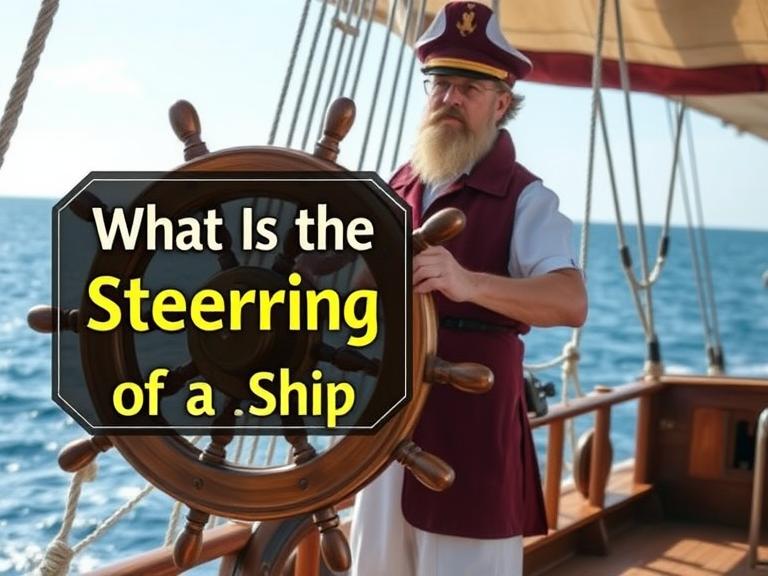When it comes to nautical terminology, many people wonder: What is the steering wheel of a ship called? While it may resemble a car’s steering wheel, the device used to control a ship’s direction has a unique name and a rich maritime history.
In this article, we’ll explore the correct term for a ship’s steering wheel, its function, historical evolution, and how it differs from other steering mechanisms.
Table of Contents
The Correct Term: Ship’s Wheel or Helm?
The steering wheel of a ship is most commonly called the “ship’s wheel” or simply the “helm.” However, there are some nuances:
- Ship’s Wheel – The physical wheel used to turn the rudder.
- Helm – Can refer to the wheel itself or the entire steering system (including the wheel, rudder, and controls).
Why Isn’t It Just Called a Steering Wheel?
- Tradition: Nautical terminology has deep historical roots.
- Precision: “Helm” includes the entire steering mechanism, not just the wheel.
How Does a Ship’s Wheel Work?
Unlike a car’s steering wheel, which directly turns the wheels, a ship’s wheel controls the rudder, which then changes the vessel’s direction.
Basic Steering Mechanism:
- The wheel is connected to cables, hydraulics, or electronic systems.
- Turning the wheel adjusts the rudder’s angle underwater.
- The rudder’s movement redirects water flow, turning the ship.
Modern vs. Traditional Systems
| Type | How It Works | Used In |
|---|---|---|
| Tiller Steering | Direct wooden lever (oldest method) | Ancient ships, small boats |
| Whipstaff (16th–17th century) | Vertical pole connected to rudder | Early sailing ships |
| Ship’s Wheel (18th century–present) | Rope/pulley system (later hydraulic/electronic) | Sailing ships, modern vessels |
| Joystick Control (Modern) | Electronic signals adjust thrusters | Luxury yachts, advanced ships |
Key Parts of a Ship’s Steering System
- Ship’s Wheel – The visible part the helmsman turns.
- Rudder – Underwater fin that changes direction.
- Tiller – Arm connecting wheel to rudder (in mechanical systems).
- Helm Console – Modern control panel (often with autopilot).
Historical Evolution of Ship Steering
1. Ancient Times: Steering Oars
- Early ships (Egyptian, Greek, Viking) used large oars on the side for steering.
- Example: Viking “steerboard” (origin of the word “starboard”).
2. Middle Ages: The Tiller
- A wooden lever directly moved the rudder.
- Common on medieval ships.
3. 18th Century: The Ship’s Wheel
- Invented to handle larger ships needing more precise control.
- Used ropes and pulleys to turn the rudder.
4. Modern Ships: Hydraulic & Electronic Steering
- Most vessels now use hydraulic pumps or fly-by-wire systems.
- Some have autopilot for long voyages.
Do All Ships Have a Wheel?
No—some vessels use alternative controls:
- Small Boats: Tillers or joysticks.
- Submarines: Yoke-style controls.
- Massive Tankers: Often use joystick or touchscreen controls.
FAQs About Ship Steering Wheels
1. Is the helm the same as the wheel?
- Helm can mean the wheel or the entire steering area (including controls).
2. Why do ship wheels have spokes?
- Spokes provide grip and leverage, especially in rough seas.
3. What is a “trick” at the helm?
- A two-hour shift where a sailor steers the ship.
4. Can a ship’s wheel turn 360 degrees?
- Older ships could spin freely; modern wheels often have limits.
5. What’s the difference between a helm and a bridge?
- Helm = Steering controls.
- Bridge = The entire command center (includes navigation, radar, etc.).
Conclusion
The steering wheel of a ship is officially called the “ship’s wheel” or “helm.” While modern technology has introduced joysticks and autopilot, traditional wheels remain iconic in maritime culture.
Understanding these terms not only clarifies nautical language but also connects us to centuries of seafaring history.

